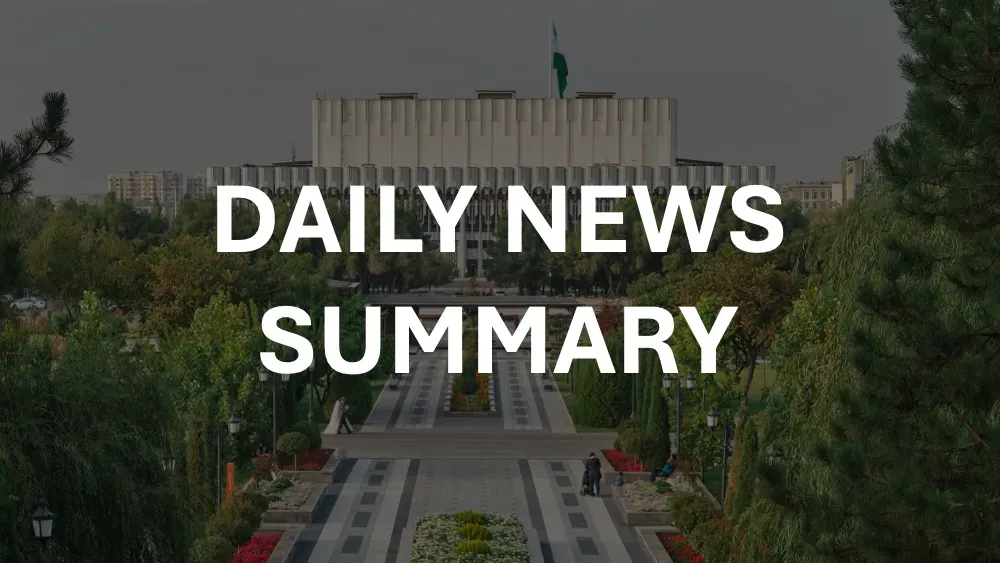📍 Get daily intelligence from Uzbekistan and Central Asia. Lexica News delivers local news that shapes global decisions—synthesized from local sources international media misses.
Construction of the China-Kyrgyzstan-Uzbekistan (CKU) railway officially launched in December 2024, marking the beginning of Central Asia's most expensive transport infrastructure project. The $8 billion initiative promises to reduce China-Europe transit time by 7-8 days and cut journey distance by 900 kilometers compared to existing routes through Kazakhstan. For international professionals operating in Uzbekistan's evolving business landscape, this railway development represents a fundamental shift in regional connectivity that affects logistics costs, trade route competitiveness, and market access strategies across Central Asia.
The 523-kilometer rail line from Kashgar through Kyrgyzstan to Andijan creates the first direct railway connection between China and Uzbekistan, bypassing traditional routes through Kazakhstan that currently handle 28 million tons annually. With China holding a 51% stake and providing $2.35 billion in low-interest loans, this project demonstrates Beijing's strategic commitment to deepening Central Asian economic integration through infrastructure investment.
Current Landscape
Uzbekistan's transport sector operates within significant cost constraints that affect business competitiveness across multiple industries. Farmers and small enterprises face transport costs reaching 200% of production costs, while the country's logistics performance ranked 88th out of 139 countries in the World Bank's 2023 Logistics Performance Index, representing an 11-point improvement from previous assessments but highlighting persistent challenges.
The existing transport infrastructure reflects Uzbekistan's double-landlocked geography, with over 42,800 kilometers of highways and 7,400 kilometers of railways supporting growing trade volumes. In 2024, public railway networks transported 73.9 million tons of cargo, reflecting 0.3% growth compared to 2023, while international transport volumes have grown at an average 10% annually over five years.
Current China-Uzbekistan trade connectivity depends on routes through Kazakhstan's Khorgos crossing via Almaty, which Uzbek officials report costs 20% more than the planned Kyrgyzstan route. This cost differential becomes significant given that bilateral trade between China and Uzbekistan reached $14 billion in 2023, representing a 45% increase from previous years.
The competitive landscape shows regional infrastructure rivalry intensifying, with Kazakhstan investing in modernizing 11,000 kilometers of highways and constructing over 5,000 kilometers of new railways by 2030. Meanwhile, Central Asia's position in China-Europe trade flows has gained strategic importance following geopolitical disruptions affecting traditional northern routes through Russia.
Documented Experiences
Current stakeholders in Uzbekistan's transport sector report mixed experiences with existing infrastructure capabilities. Foreign road carriers handle approximately 82% of imported and exported goods due to limited competitiveness of domestic trucking services, indicating systematic challenges in local logistics capacity.
Recent improvements show measurable progress in specific areas. According to CAREC data from 2022, road transport border-crossing time decreased from 7.6 hours to 4.2 hours, while border-crossing costs fell from $92 to $74. However, total road transport costs increased from $674 to $687, demonstrating how efficiency gains in some areas coincided with cost pressures elsewhere.
Railway performance data reveals capacity constraints affecting freight movement. Total rail transport costs decreased from $665 to $635 between measurement periods, suggesting operational improvements. Yet the 2024 cargo volume of 73.9 million tons with minimal growth indicates infrastructure limitations constraining expansion.
Export-oriented businesses document specific challenges with transport cost structures. The government introduced partial compensation systems for export transport costs to reduce burdens on local producers, acknowledging that transport expenses significantly impact export competitiveness. These measures address documented cases where transport costs approach or exceed production costs for agricultural and manufacturing sectors.
International shipping experiences through existing routes show time and cost inefficiencies. Current China-bound cargo travels through Kazakhstan's network, adding approximately 900 kilometers to journey distances compared to direct routing through Kyrgyzstan. Logistics companies report that routing flexibility remains limited, with Kazakhstan maintaining dominant positions in regional transport corridors.
Stakeholder Realities
Government data presents ambitious infrastructure development targets that contrast with private sector experiences. Official statistics show transit transport growth reaching 12% in 2023, with authorities projecting continued expansion through strategic corridor development. The Ministry of Transport, established in 2019, coordinates implementation of comprehensive infrastructure modernization programs extending to 2035.
Business community responses reveal cautious optimism tempered by implementation concerns. Trade between China and Uzbekistan increased by over 50% from 2022 to 2023, demonstrating growing commercial relationships that could benefit from improved transport connections. However, companies operating in export sectors continue reporting cost pressures that affect competitiveness in international markets.
Local transport operators face competitive pressures from foreign carriers dominating freight services. The concentration of transport services among non-domestic providers indicates structural challenges in developing local logistics capabilities. Government initiatives to support domestic transport companies have shown limited success in shifting market share away from foreign operators.
International development organizations document infrastructure financing needs exceeding current investment levels. The Asian Development Bank estimates Central Asia requires infrastructure investments valued at 7.8% of GDP through 2030, higher than East Asian requirements but reflecting the region's development priorities. These estimates suggest current investment levels, while substantial, remain below optimal levels for achieving development objectives.
Regional partners express varying perspectives on transport corridor development. Kazakhstan views new railway projects as competitive challenges to its established position in China-Europe trade flows, while Chinese officials emphasize regional connectivity benefits that support broader Belt and Road Initiative objectives. Kyrgyzstan positions itself as a beneficiary of transit revenue opportunities, though infrastructure financing requirements present fiscal challenges.
Understand Uzbekistan Like an Insider
This analysis draws from extensive research, but the story continues to evolve daily. Lexica synthesizes breaking developments from dozens of Uzbek news sources—from mining policy changes to local protests that never make international headlines.
Our daily intelligence briefs help executives, diplomats, and researchers track:
- Regulatory shifts affecting foreign investment
- Local opposition to development projects before they escalate
- Market dynamics that signal opportunity or risk
- Political developments that reshape the business landscape
Operational Context
The CKU railway project operates within a complex financing structure reflecting international infrastructure development patterns. China Railway Corporation holds a 51% stake with Chinese institutions providing $2.35 billion in low-interest loans, while Uzbek and Kyrgyz railway companies each maintain 24.5% ownership shares. This arrangement requires each partner country to contribute approximately $573 million in equity financing.
Construction timelines follow standard international railway project patterns. Official construction begins in July 2025 with a six-year completion schedule, targeting operational status by 2031. The 280-kilometer section through Kyrgyzstan requires an estimated $4.7 billion investment, reflecting challenging mountainous terrain and technical specifications for 120 km/hour design speeds.
Regulatory frameworks governing international railway operations require coordination among three sovereign jurisdictions. Transit arrangements, customs procedures, and cross-border protocols must accommodate different legal systems while maintaining operational efficiency. Previous experience with similar projects in Central Asia shows that administrative coordination often presents greater challenges than technical construction issues.
Current market conditions affect project economics through currency fluctuation and commodity price impacts. The Uzbek som depreciated 3.7% against the US dollar in 2024, compared to 8.4% depreciation in 2023, indicating improving monetary stability that supports long-term infrastructure investment planning. However, construction cost inflation remains a risk factor for project budget management.
Freight capacity projections anticipate 15 million tons annual throughput once operations commence, though actual volumes depend on competitive positioning relative to existing routes. Kazakhstan's current facilities handle 28 million tons annually through border crossings with China, providing benchmark capacity levels for regional comparison.
Regional Comparison
Kazakhstan maintains advantages in established infrastructure and operational experience, with a 21,000-kilometer railway network supporting diverse economic sectors. The country's Altynkol station and Dostyk crossing handle 28 million tons annually, demonstrating proven capacity for China-Europe trade flows. Investment plans include modernizing 5,000 kilometers of track and repairing 11,000 kilometers by 2030, indicating continued competitive positioning efforts.
Uzbekistan's railway network spans 7,400 kilometers with planned 65% electrification by 2025, supported by over $1 billion annual modernization investments. The country's strategic advantages include population of 36 million representing Central Asia's largest domestic market and strong defense capabilities contributing to regional stability.
Regional trade performance shows differentiated growth patterns across Central Asian states. Kazakhstan recorded $41 billion in bilateral trade with China representing 32% growth, while Uzbekistan achieved $14 billion with 45% growth, indicating faster expansion from a smaller base. Kyrgyzstan reached $19.8 billion with 28.8% growth, though much of this reflects re-export activities rather than domestic production.
Transport cost comparisons reveal competitive disadvantages affecting regional positioning. Uzbekistan's logistics ranking of 88th globally represents improvement but remains below optimal levels for international competitiveness. Kazakhstan benefits from more developed logistics infrastructure, though both countries face challenges from geographic constraints as landlocked economies.
Investment attraction capabilities show varying success levels across regional competitors. Central Asian countries received $22.6 billion in CAREC financing since 2001, with transport sector projects receiving 70% of total funding. This distribution reflects infrastructure development priorities but also highlights the substantial financing requirements for maintaining competitive positions in evolving trade corridors.
FAQ
What specific cost savings does the China-Kyrgyzstan-Uzbekistan railway offer compared to existing routes?
Current routing through Kazakhstan costs approximately 20% more than planned Kyrgyzstan connections, according to Uzbek officials. The new railway reduces journey distances by 900 kilometers and delivery time by 7-8 days compared to existing China-Europe routes. However, actual cost savings depend on operational efficiency, border processing times, and competitive pricing strategies once the railway becomes operational in 2031.
How does Uzbekistan's current transport infrastructure compare to regional competitors?
Uzbekistan ranks 88th globally in the World Bank's 2023 Logistics Performance Index, representing improvement from previous assessments but remaining below Kazakhstan's performance levels. The country operates 7,400 kilometers of railways compared to Kazakhstan's 21,000 kilometers, though Uzbekistan plans 65% electrification by 2025. Foreign carriers handle 82% of Uzbekistan's import-export freight, indicating domestic logistics sector development needs.
What are the documented challenges affecting transport costs for Uzbekistan businesses?
Small enterprises and farmers report transport costs reaching 200% of production costs, significantly affecting export competitiveness. Total road transport costs increased from $674 to $687 between recent measurement periods, despite border-crossing time improvements. The government introduced partial compensation systems for export transport costs, acknowledging these challenges impact business operations across multiple sectors.
How reliable is the projected timeline for CKU railway completion?
Construction officially begins in July 2025 with a six-year completion schedule, targeting 2031 operational status. This timeline follows standard international railway project patterns, though mountainous terrain through Kyrgyzstan presents technical challenges. Previous Central Asian infrastructure projects have experienced delays due to financing coordination and regulatory approval processes, though the current project benefits from committed Chinese financing and completed feasibility studies.
What capacity levels can businesses expect from the new railway?
Projected annual capacity reaches 15 million tons once operational, designed for 120 km/hour speeds along the 523-kilometer route. For comparison, Kazakhstan's existing China border crossings handle 28 million tons annually, providing regional benchmark capacity levels. Actual utilization depends on competitive positioning, freight routing decisions, and development of supporting logistics infrastructure in connected regions.
How do financing arrangements affect project implementation risks?
China provides $2.35 billion in low-interest loans while maintaining 51% project ownership, with Uzbekistan and Kyrgyzstan each contributing approximately $573 million for 24.5% stakes. This structure reduces financing risks for partner countries but creates dependency on Chinese project management and operational standards. Currency stability improvements in Uzbekistan, with som depreciation decreasing from 8.4% to 3.7% annually, support local financing contributions.
What regional competitive dynamics affect the railway's strategic value?
Kazakhstan views the CKU railway as competition to its dominant position in China-Europe trade corridors and is investing heavily in infrastructure modernization through 2030. The Middle Corridor through Central Asia has gained strategic importance following geopolitical disruptions affecting northern routes through Russia. Alternative corridors including Iran connections could further reshape regional transport patterns, affecting individual country competitive positions.
Conclusion
The China-Kyrgyzstan-Uzbekistan railway represents a significant infrastructure investment that addresses documented transport cost challenges while introducing new competitive dynamics in Central Asian trade corridors. Current data shows Uzbekistan faces substantial logistics performance gaps, with transport costs reaching 200% of production costs for some sectors and foreign carriers dominating freight services. The $8 billion railway project offers measurable improvements including 900-kilometer distance reductions and 7-8 day time savings, though actual business benefits depend on operational efficiency and competitive pricing once the system becomes operational in 2031.
Stakeholder experiences reveal mixed progress in transport sector development, with border-crossing time improvements offset by persistent cost pressures affecting export competitiveness. The financing structure through Chinese loans and equity participation creates implementation advantages while establishing long-term operational relationships among three countries with different economic development levels and regulatory frameworks.
Regional comparison data indicates intensifying competition for China-Europe trade flows, with Kazakhstan maintaining established advantages in capacity and operational experience while Uzbekistan pursues direct connectivity to reduce dependency on transit arrangements. Market developments worth monitoring include China-Central Asia trade growth continuing at 27% annual rates, infrastructure investment flows exceeding current levels, and alternative corridor development affecting competitive positioning across regional transport networks.
Track Uzbekistan with Local Intelligence
The rare earth story exemplifies why local sources matter. While international media reports MOUs and ministerial visits, Uzbek outlets cover the community protests, water disputes, and regulatory changes that actually determine project outcomes.
Lexica delivers what you're missing:
- Daily briefs at 7AM Tashkent time covering 40 top stories from politics to economics
- Full-text synthesis from sources in Uzbek
- Searchable archive to track how today's announcements connect to yesterday's promises
- Multi-country coverage across Central Asia for regional context
Whether you're evaluating investment opportunities, monitoring supply chain risks, or analyzing geopolitical developments, local intelligence reveals what international headlines obscure.










